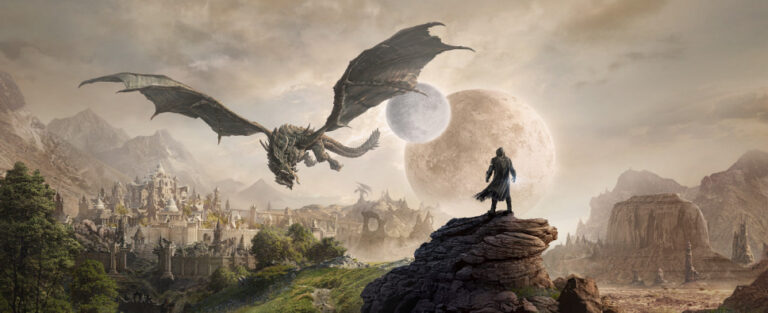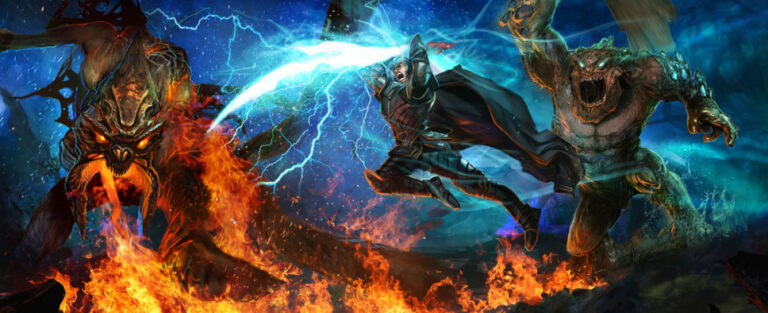Though I own most of the new gaming consoles, a good computer, and many recent games, you’d never guess that I’ve been having a blast playing the 1994 classic Might and Magic: World of Xeen using DOSBox. If you’re old enough, you’ll remember the golden age of RPG gaming: the aforementioned Might and Magic series, SSI’s Gold Box games, Sir-tech’s Wizardry series, ORIGIN’s Ultima series, Westwood’s Eye of the Beholder series, FTL Games’ Dungeon Master, and an assortment of others. You might even still have your intricate maps on graph paper tucked away in a place you’ve long forgotten about, as auto-mapping had not yet been successfully implemented in many of these games.
As I’m going through Might and Magic IV & V for a second time (called World of Xeen when combined), it reminded me back when I first bought Might and Magic III: Isles of Terra, which used the same engine. In its day it was one of the cutting edge (insert laughter) 256 color graphic games, one of which took advantage of the newer computers and graphic cards of the day. It also included a brand new 3D-esque world as well as mouse control ala Dungeon Master. That in itself wasn’t new at the time, but it also featured a huge world in which to explore and that was – and is – exciting.
Obviously if I’m playing this there’s some value in it, for me at least. Why, for example, am I playing this a second time instead of the record-shattering GTA IV or the critically acclaimed The Witcher? It’s not just for nostalgia’s sake. In this article I’m going to talk about what made the Might and Magic games one of the classic RPG series in history, and what designers of today can glean from it.
Might and Magic III contained a wonderful element from the very beginning – reward the player for exploration, and reward them well. This was a game of tiles and though it had roads, paved safer paths, and cities, it had skills for mountaineering that let you travel across mountain tiles. Pathfinding let you travel through trees. Swimming allowed you to explore the water. There were skills that were specifically designed for exploration. That’s a concept that really hasn’t been touched since except for maybe the Metroid series. It worked wonders in that, and also in Might and Magic.
When off the beaten path, players want to find something special. It’s why they go off the path in the first place. In real life, when you do, you always find something unexpected. It’s natural to seek this out in a game. It’s why in any MMO I try out, I’m the “explorer” type of personality. I’ll go to the ends of the world, by myself, just to see what’s there and map out the place. I want to see unique creatures, visit areas that are too difficult for me, or discover unique vistas you won’t find by using the main pathway.
So the first thing that this game had was its excellent use of rewarding players with immediate experience for exploration – for say, burning down an orc encampment. After that, you revisited town, trained up a couple levels, and were more powerful just for exploration. No battles, no mess. Just fun, and a strange feeling that this somehow was the right way to play. Reward players when they go off the path or do something unexpected.
Secondly, this game had big rewards. When you completed a quest, your characters received a full ox load of experience, money, and items. Not just a reward, but big enough rewards that really meant something. In today’s RPGs, a completed quest will typically net you a small amount of experience that’s just enough to feel like you’re making progress toward the next level. Answer me this – why do many people enjoy starting new brand characters in RPGs or MMOs? There are gameplay changes, sure, but it’s also because of the quick, extensive reward system that’s usually found early in the game. You literally start out at zero with only a couple of skills, but very quickly gain levels and get new skills.
Now, of course this couldn’t continue indefinitely or there’d be an overabundance of skills, abilities, or what have you. But if you make rewards diverse, and have big payoffs, you’ll get more satisfaction. Why has Diablo II held such a strong addiction for so many years? It was because at any time, you could get rewarded huge. That’s what we need more of. Big or eventful rewards when accomplishing something.
Here’s another thing the game had going for it. You were usually a degree of power more powerful than your average fight, and when you weren’t, you knew it. This led to the occasional battle where you really scraped to survive and make it to the healer after 5 of your 6 party members were dead (R.I.P.). But for the other fights, you could usually mow them down with good spells. Challenge is a huge concept in an RPG or any game, and finding the right formula is key. But all too often lately, designers have been keeping the player at just above the challenge level, instead of another degree above. In games, we really do want our characters to maintain that solid degree of “betterness” above the challengers. We don’t want the game to be too easy, but we want to maintain that control and dominance over the AI and if it gets too close for too long, and we don’t make it, for most of us, that’s frustrating rather than a reason to continue. Therefore, keep the challenge moderate for experienced players, challenging for less experienced players, but at most times, doable. Put level of difficulties in that allow the hardcore competitor to get his/her fill, but keep the default at a moderate challenge for those that keep their characters up to date. It is ok for characters to become “godly”, really.
Might and Magic also had no respawning creatures one feature that’s always bugged me. Even in Metroid Prime, one of my all-time favorite games, it annoyed me to some extent. I put up with it, but I’ll say that it wasn’t “fun”. It was a necessary design decision to make re-explorable areas become non-static. I get that. But if you can help it, make creatures stay dead. Or, have a system like Fallout or many others where when you’re exploring, there’s a random chance of an encounter. Even then, when you become more powerful, you should decrease the chance until it’s eventually 0% that you encounter “challenges” for that area.
Moving on, the series had no “leveled” creatures. These are creatures whose level depended on your own so they could always present a challenge. Why isn’t level scaling a good thing? For one, it makes exploration less fun. You realize that when you get somewhere, you’ll find an acceptable challenge, nothing more. It decreases the tension that perhaps you’ll find instant death, or the exhilaration when you unexpectedly trounce through a new area unscathed. Secondly, it’s unrealistic. Sure, the world, magic, and everything else is too, but without level scaling you at least know you’re going to find areas where the creatures are simply too powerful and be denied entrance for that reason, or find them accommodating and be allowed through. It fits with our current suspended paradigm.
We also have a meld of sci-fi and fantasy with Might and Magic. It was one of the weird quirky things about the series, though it was also present in the Wizardry series. In Might and Magic, though, it was one of those unexpected events that happened later in the game, when you’d finally discover that there was a connection with a superior alien race. Heck, while playing Might and Magic VI late in the game, you even have access to laser guns! What’s this mean for designers? To me, it means make your game unique or stand out. That feature will always be something Might and Magic was known for. What will that be for your game? It’s one thing to make your game be known for a unique technical or art achievement… like Trespasser was for its physics (and you remember how well that went). It’s another to have your great game be remembered for an actual gameplay or story uniqueness. Those are usually the fondly remembered games. Planescape: Torment’s companions and setting, KotOR’s story twist, or even Final Fantasy VII as a whole. Gameplay and story. That’s where you want your differentiation.
The list wouldn’t be complete without mentioning Might and Magic’s powerful utility spells. Late in the game you’re able to learn the cast-once-and-leave Day of Sorcery (Wizard) and Day of Protection (Cleric), which essentially take all of the micromanaging out of casting buffs for your party. Throughout the game you’d learn bless, walk on water, heroism, light, wizard eye (for seeing extra map areas), etc. What these two spells did was combine all of the useful buffs you’d always want on your party into one or two spells. Cast them at the beginning of the day, and just go adventure without needing to cast one at a time. This is something that I believe would benefit MMOs like World of Warcraft that feature party support roles. As your character gets more powerful, why not give them less micromanaging and have one spell that does everything they’d typically do anyway in one cast, for more mana? This was forward thinking for its day and should remain relevant in today’s games.
A few other things that the series did great was instant travel mirrors if you knew the location, flight in Might and Magic VI and beyond because of the 3D world, exploration to get character progression (to find the masters and grandmaster teachers), smaller dungeons (in and out usually), and optional mind puzzles for greater rewards.
In my opinion, these are just many of the aspects we can take from older games and make new and refreshing in the games of today. Until then, to experience great games of yesteryear on your computer of today, you can visit www.dosbox.com.






